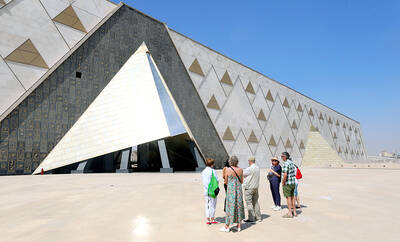Canadian Prime Minister Justin Trudeau’s government is boosting military spending and expanding trade ties in the Indo-Pacific region as part of a “generational” policy shift aimed at countering China’s influence.
Canadian Minister of Foreign Affair Melanie Joly on Sunday morning released her nation’s Indo-Pacific strategy, including nearly US$1.7 billion in spending. That money is being used for more navy patrols in the region, better intelligence and cybersecurity measures, and increased cooperation with regional partners in the East and South China seas.
The 26-page document — unveiled by Joly and a trio of other ministers in Vancouver, with Trudeau’s defense head holding a virtual briefing later on Sunday — includes a lengthy section on China, which it refers to as an “increasingly disruptive global power.”

Photo: Reuters
It cites multiple military, security and economic threats posed by the Beijing, while acknowledging the need to work with it on issues such as climate change, global health, biodiversity and nuclear nonproliferation.
Joly, in an hour-long interview with Bloomberg News ahead of the strategy statement’s release, said the world’s geopolitical “tectonic plates” are shifting. That is threatening international norms that have kept the world safe since World War II, as well as creating supply chain uncertainty and inflation.
“When it comes to China, we know that there’s a battle of influence happening in the region,” she said on Friday in Montreal. “So we have to step up our game.”
Canada will also toughen its rules around foreign investment and take other steps to defend itself from “foreign interference,” the document says.
Its publication comes less than two weeks after Chinese President Xi Jinping (習近平) confronted Trudeau on the sidelines of the G20 summit in Indonesia, admonishing the Canadian leader for providing the media with information about an earlier discussion.
Joly told Bloomberg the encounter did not surprise her, as she has also had “frank conversations” with her Chinese counterpart in the course of diplomacy.
“You saw what we see happening normally,” she said. “You just had a glimpse of the political reality.”
She also said crafting an Indo-Pacific strategy would have been fruitless without addressing China’s growing influence, “the elephant in the room.”
Canada will increase its diplomatic and trade presence to create a more predictable environment for business investment in Asia, Joly said, adding that it plans to invest C$750 million (US$558 million) in sustainable infrastructure projects, which it hopes would attract further capital from Canadian pension funds.
At the same time, increased military cooperation with regional partners would protect the country’s Pacific interests, just as alliances with Europe through NATO, and the US through the North American Aerospace Defense Command, have historically protected its Arctic and Atlantic interests, she said.
Canada would invest almost C$500 million over five years on enhanced defense in the region, she said.
“For a long time we’ve defined ourselves through the relationship we have with Europe,” Joly said. “It is time to look towards the Pacific.”
The strategy contains a section devoted to deepening economic ties with India, and another devoted to Japan and South Korea — a neighborhood it dubs the North Pacific.
Canada has struggled to diversify its Pacific trading relationships beyond China, its second-largest trade partner after the US. Trade with China totaled C$125.8 billion in the last 12 months to September, representing 8.6 percent of trade flows, Statistics Canada data showed. That compares with less than 7 percent from all other major Indo-Pacific countries combined — a proportion that is little changed since 1997, when Canada-China trade was minimal.
There are numerous planks in the strategy meant to grow Canada’s trade relationships, including a new series of “Team Canada” trade missions to bring business leaders to Indo-Pacific countries, and a C$65.1 million program to increase Canada’s science and research partnerships with Taiwan, South Korea, India, Japan and Singapore.
The C$750 million infrastructure program is the largest ticket item in the plan, and is part of Canada’s contribution to the US$600 billion G7 infrastructure plan announced earlier this year to counter China’s Belt and Road program.

With much pomp and circumstance, Cairo is today to inaugurate the long-awaited Grand Egyptian Museum (GEM), widely presented as the crowning jewel on authorities’ efforts to overhaul the country’s vital tourism industry. With a panoramic view of the Giza pyramids plateau, the museum houses thousands of artifacts spanning more than 5,000 years of Egyptian antiquity at a whopping cost of more than US$1 billion. More than two decades in the making, the ultra-modern museum anticipates 5 million visitors annually, with never-before-seen relics on display. In the run-up to the grand opening, Egyptian media and official statements have hailed the “historic moment,” describing the

‘CHILD PORNOGRAPHY’: The doll on Shein’s Web site measure about 80cm in height, and it was holding a teddy bear in a photo published by a daily newspaper France’s anti-fraud unit on Saturday said it had reported Asian e-commerce giant Shein (希音) for selling what it described as “sex dolls with a childlike appearance.” The French Directorate General for Competition, Consumer Affairs and Fraud Control (DGCCRF) said in a statement that the “description and categorization” of the items on Shein’s Web site “make it difficult to doubt the child pornography nature of the content.” Shortly after the statement, Shein announced that the dolls in question had been withdrawn from its platform and that it had launched an internal inquiry. On its Web site, Le Parisien daily published a

China’s Shenzhou-20 crewed spacecraft has delayed its return mission to Earth after the vessel was possibly hit by tiny bits of space debris, the country’s human spaceflight agency said yesterday, an unusual situation that could disrupt the operation of the country’s space station Tiangong. An impact analysis and risk assessment are underway, the China Manned Space Agency (CMSA) said in a statement, without providing a new schedule for the return mission, which was originally set to land in northern China yesterday. The delay highlights the danger to space travel posed by increasing amounts of debris, such as discarded launch vehicles or vessel

RUBBER STAMP? The latest legislative session was the most productive in the number of bills passed, but critics attributed it to a lack of dissenting voices On their last day at work, Hong Kong’s lawmakers — the first batch chosen under Beijing’s mantra of “patriots administering Hong Kong” — posed for group pictures, celebrating a job well done after four years of opposition-free politics. However, despite their smiles, about one-third of the Legislative Council will not seek another term in next month’s election, with the self-described non-establishment figure Tik Chi-yuen (狄志遠) being among those bowing out. “It used to be that [the legislature] had the benefit of free expression... Now it is more uniform. There are multiple voices, but they are not diverse enough,” Tik said, comparing it